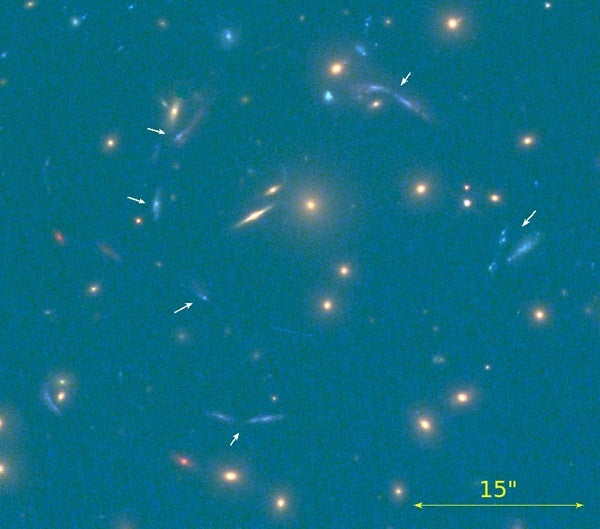The galaxy, dubbed WISE J132934.18+224327.3, is an ultrabright submillimeter galaxy, meaning its light is largely emitted at submillimeter (far infrared) wavelengths. It is one of the brightest submillimeter galaxies ever detected, shining a thousand times brighter than our Milky Way. The galaxy was discovered by comparing two astronomical survey catalogs: the AllWISE and Planck compact source catalogs. A team from the Instituto de Astrofisica de Canarias (IAC), led by Anastasio Díaz-Sánches of the Polytechnic University of Cartagena, followed up on the galaxy with the 10.4-meter Gran Telescopio Canarias to more precisely measure its properties. Their work was recently published in The Astrophysical Journal Letters.
“Thanks to the gravitational lens … the galaxy appears 11 times bigger and brighter than it really is, and appears as several images on an arc centered on the densest part of the cluster, which is known as an ‘Einstein Ring.’ The advantage of this kind of amplification is that it does not distort the spectral properties of the light, which can be studied for these very distant objects as if they were much nearer,” said Díaz-Sánches in a press release.
Thus, gravitational lensing allows astronomers to study this galaxy in greater detail than would normally be possible, revealing clues that are difficult or even impossible to tease out of non-lensed galaxies because they appear so small. Furthermore, because the object is so bright, its inner workings become even easier to observe.
For example, the team has determined that WISE J132934.18+224327.3 is forming stars at a rate of 1,000 solar masses per year, which is 500-1,000 times the current rate of the Milky Way (one to two solar masses per year). “This type of objects harbor the most powerful star forming regions known in the universe,” said team member Susana Iglesias-Groth.
Submillimeter galaxies like this one play a vital part in creating the universe we see around us today. These dusty, star-forming galaxies are thought to evolve into the aging elliptical galaxies observed in the nearby universe. Studying this very bright example will thus help astronomers learn more about how the earliest galaxies formed their stars and changed over time.
The team plans to follow up their current observations at radio observatories like the Northern Extended Millimeter Array (NOEMA/IRAM) in France and the Atacama Large Millimeter/submillimeter Array (ALMA) in Chile.










